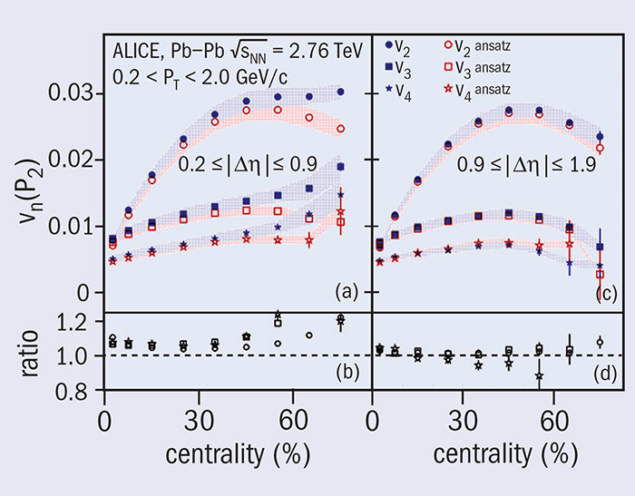
The study of the anisotropic flow in heavy-ion collisions at the LHC, which measures the momentum anisotropy of the final-state particles, has been effective in characterising the extreme states of matter produced in such collisions. Much evidence of collective anisotropic flow and the production of a quark–gluon plasma (QGP) in heavy-ion collisions has already been reported. However, ALICE recently devised a new technique to test for the collective nature of the flow using measurements of differential transverse-momentum correlators, P2. These quantities measure the degree of correlation between the momenta of produced particles and are used to probe the evolution of the QGP fireball produced in heavy-ion collisions. For specific dynamic processes, one can derive how the shape and strength of momentum correlations is related to those of particle-number correlations.

Collective-flow models posit that the enormous energy density achieved in heavy-ion collisions generates large pressure gradients that drive the expansion of the QGP fireball. In non-central collisions, the nuclear overlap region is anisotropic and approximately almond shaped, with the longer axis oriented perpendicular to the reaction plane formed by the impact parameter and the beam direction. This produces pressure gradients that are largest in the reaction plane. Particle production thus becomes an anisotropic and collective process mostly determined by the orientation relative to the reaction plane. The anisotropy in the transverse plane is quantified in terms of Fourier coefficients (vn), whose values depend on the initial spatial anisotropy of the fireball as well as pressure gradients. If the geometry of the system and the pressure gradients dominate correlations of produced particles, one expects a specific scaling relation between vn[P2] coefficients of momentum correlations and the regular flow coefficients vn. The presence of other sources of particle correlation, generically called non-flow, are expected to break this simple scaling, however.
ALICE has now found that the scaling relation between vn[P2] and regular vn coefficients is well verified for particle pairs with a minimum separation of 0.9 unit of rapidity (figure, right panel), but breaks down for shorter intervals (left panel) where non-flow effects such as resonance decays and jet fragmentation play an important role. The observed scaling at rapidity greater than 0.9 thus confirms that collective flow determined by the geometry of the collision system dominates the correlation dynamics in heavy-ion collisions at the LHC. ALICE also observed, in the five per cent most central collisions, that the third-order coefficients v3[P2] are larger than the second-order coefficients, v2[P2]. Such coefficient hierarchy is also observed in particle-number correlations but only for the two per cent most central collisions. The observable P2 thus provides better sensitivity to initial state fluctuations that engender finite third-harmonic values.





